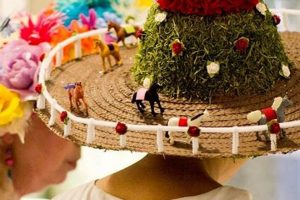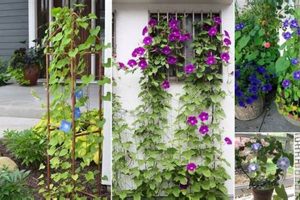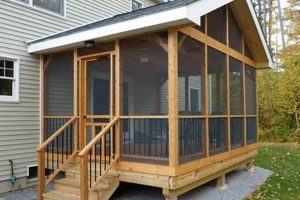Creating equine-themed attire at home involves constructing a costume that resembles a horse, typically for festive occasions like Halloween or costume parties. These creations range from simple headbands with ears to elaborate full-body representations utilizing materials such as cardboard, fabric, and craft supplies. An example might be assembling a horse head from felt and attaching it to a stick for a child’s hobbyhorse representation.
Homemade animal costumes offer a cost-effective alternative to purchasing pre-made options, promoting creativity and resourcefulness. This approach allows for personalization and adaptation to individual preferences or available materials. Historically, creating costumes has been a traditional practice, reflecting cultural narratives and artistic expression. The benefits extend to educational settings where such projects foster problem-solving skills and collaborative learning.
The following sections will outline various approaches to constructing these unique costumes, including considerations for materials, design elements, and construction techniques. Detailed instructions and illustrative examples will be provided to guide the creation process, ensuring a successful and enjoyable outcome.
Construction Strategies for Equine-Themed Attire
The following are strategies to consider when embarking on the construction of a do-it-yourself horse costume.
Tip 1: Material Selection: Prioritize lightweight and breathable materials to ensure comfort, particularly for extended wear. Fabrics such as felt, fleece, and burlap offer a balance of durability and ease of manipulation. For structural elements, consider utilizing recycled cardboard or foam padding.
Tip 2: Design Simplicity: Initiate the design with a simplified silhouette, gradually adding detail as the construction progresses. Overly complex designs can quickly become unwieldy and difficult to execute. Focus on recognizable features like the head, mane, and tail.
Tip 3: Proportional Accuracy: Strive for accurate proportions when replicating the horse’s anatomy. While a cartoonish style may be desirable, maintaining a degree of realism enhances the overall impact of the costume. Reference images are invaluable for achieving this.
Tip 4: Secure Fastenings: Employ robust fastening mechanisms such as adjustable straps, Velcro closures, and sturdy stitching to ensure the costume remains securely in place during movement. Weak or unreliable fastenings compromise both the appearance and safety of the wearer.
Tip 5: Mobility Considerations: Design the costume to allow for a reasonable range of motion. Restricting movement can lead to discomfort and potentially hazardous situations. Incorporate flexible joints and ample space around the limbs.
Tip 6: Color Palette: Select a cohesive color palette that accurately reflects the desired breed or aesthetic. While creative liberties are permissible, a thoughtful color scheme enhances the visual appeal of the costume. Consider using contrasting colors for the mane and tail to add visual interest.
Tip 7: Detailing and Embellishments: Incorporate details such as simulated muscles, realistic eyes, and textured manes to elevate the realism of the costume. Utilize materials like yarn, faux fur, and paint to create these embellishments.
Adherence to these construction strategies will significantly improve the overall quality and functionality of the homemade horse costume, providing a satisfying and visually impressive result.
These strategies provide a foundation for successful creation. The following sections will cover assembly and potential modifications.
1. Materials
The selection of materials is paramount to the success of crafting do-it-yourself horse costumes. The chosen substances directly influence the costume’s weight, durability, aesthetic appeal, and wearer comfort. Inappropriate material selection can result in a costume that is structurally unsound, uncomfortable to wear for extended periods, or lacking in visual realism. For example, using heavy cardboard for a full-body horse costume may create a sturdy structure but could also severely restrict movement and cause discomfort, particularly for a child. Conversely, selecting lightweight fabrics such as felt or fleece for the main body, combined with strategically placed foam padding for shape, provides a balance between structural integrity and comfort. The material’s texture also contributes to realism; incorporating faux fur for the mane and tail enhances the visual authenticity.
Further practical considerations arise in terms of material cost and ease of manipulation. Readily available and inexpensive materials such as cardboard boxes, fabric remnants, and craft foam are often favored for budget-conscious projects. However, more specialized materials like realistic-looking faux fur or durable plastic sheeting for hooves might be required to achieve a higher level of realism. The construction method is also intrinsically linked to material choice. Sewing techniques are appropriate for fabric components, while adhesives and fasteners are necessary for combining cardboard or foam elements. A well-planned material inventory, coupled with appropriate construction techniques, streamlines the creation process and minimizes potential issues related to structural integrity or aesthetic inconsistencies.
In summary, the appropriate selection of materials is a foundational element in the design and construction of do-it-yourself horse costumes. It dictates the costume’s comfort, durability, and overall visual impact. Prioritizing lightweight, breathable materials, considering cost and availability, and aligning material choice with appropriate construction methods are crucial steps towards creating a successful and visually appealing final product. Failure to carefully consider these factors can result in a substandard costume that lacks durability, comfort, or aesthetic appeal.
2. Construction
The construction phase represents the core element in realizing homemade equine-themed attire. This phase involves the practical application of design principles and material selection to transform raw materials into a wearable costume. Effective construction directly correlates with the costume’s structural integrity, visual appeal, and overall usability.
- Pattern Creation and Adaptation
This involves either drafting patterns from scratch or adapting existing templates to suit the specific design. Accurate pattern creation is essential for ensuring proper fit and proportions. Examples include scaling up a hobby horse pattern for a child’s full-body costume or modifying a commercial animal costume pattern to incorporate equine-specific features. Improper pattern creation can lead to ill-fitting components and a distorted final product.
- Assembly Techniques
Assembly refers t
o the methods used to join various components of the costume. Sewing, gluing, stapling, and riveting are common techniques, each suited to different materials and structural requirements. For instance, fabric elements are typically sewn together, while cardboard components might be glued or stapled. Robust assembly techniques are crucial for ensuring the costume’s durability and preventing structural failures during wear. Poorly executed assembly compromises the costume’s lifespan and safety. - Structural Reinforcement
Adding internal supports or reinforcing weak points is crucial, especially for larger or more complex costumes. This can involve incorporating wire frames, foam padding, or strategically placed cardboard inserts. Reinforcement is essential for maintaining the costume’s shape and preventing sagging or collapse. Neglecting structural reinforcement leads to a flimsy and unattractive costume.
- Fastening Mechanisms
Secure and reliable fastening mechanisms are vital for keeping the costume securely in place during movement. Options include adjustable straps, Velcro closures, zippers, and snaps. The choice of fastening mechanism depends on the costume’s design and the wearer’s needs. Inadequate fastening mechanisms can result in the costume shifting or falling apart during use, posing a safety hazard.
These facets of construction collectively dictate the final outcome of the do-it-yourself horse costume. A well-executed construction phase ensures a durable, visually appealing, and comfortable costume that meets the design specifications. Conversely, neglecting any of these facets can result in a substandard costume that fails to meet expectations.
3. Comfort
The element of comfort bears a direct and significant relationship to successful homemade equestrian-themed attire. An uncomfortable costume, regardless of its visual appeal, is unlikely to be worn for extended durations, thereby negating its intended purpose. This element encompasses multiple factors, including the breathability of materials, the freedom of movement afforded by the design, and the absence of abrasive components that may irritate the wearer’s skin. For example, a full-body horse costume constructed from non-breathable materials such as vinyl or tightly woven synthetics can cause overheating and discomfort, especially during physical activity. Conversely, a costume utilizing breathable fabrics and a design that allows for a full range of motion contributes positively to the wearer’s experience, encouraging longer periods of use and enjoyment.
Practical implications of addressing comfort considerations are evident in the design and material selection phases. Costumes incorporating articulated joints, allowing for greater limb movement, enhance mobility and reduce strain on the wearer. Similarly, the inclusion of adjustable straps or elastic elements accommodates variations in body size and shape, ensuring a more personalized and comfortable fit. Real-world examples include designs with padded shoulder straps to distribute weight evenly and avoid chafing, or costumes with removable headpieces to allow for ventilation and prevent overheating. These adaptations demonstrate an understanding of the practical challenges associated with wearing elaborate costumes and a commitment to prioritizing the wearer’s well-being.
In conclusion, comfort represents an indispensable component of a successfully realized do-it-yourself horse costume. Its absence can render an otherwise visually impressive creation impractical and unenjoyable. By prioritizing breathability, mobility, and ergonomic design principles, creators can significantly enhance the wearer’s experience and ensure that the costume is worn and appreciated as intended. The challenge lies in balancing aesthetic ambitions with the practical needs of the wearer, a balance that ultimately determines the success or failure of the project.
4. Durability
The inherent lifespan and resistance to wear are key considerations within the context of constructing equine-themed attire at home. The long-term usability of the resulting costume is intrinsically linked to the selection of robust materials and the application of sound construction methodologies.
- Material Selection and Resilience
The chosen materials directly influence the costume’s ability to withstand repeated use and potential damage. For example, utilizing a tightly woven, durable fabric like canvas or heavy-duty felt for the main body of the costume, as opposed to a flimsy, easily torn material like tissue paper, significantly extends its lifespan. This choice also affects resistance to environmental factors like moisture and sunlight, which can degrade less resilient materials. The appropriate selection mitigates the risk of premature wear and tear, ensuring prolonged usability.
- Seam Strength and Reinforcement
The integrity of seams and joints is paramount to the costume’s overall robustness. Employing reinforced stitching techniques, such as backstitching or using a serger to prevent fraying, enhances the durability of fabric-based components. Similarly, for costumes incorporating non-fabric elements like cardboard or foam, the use of strong adhesives or mechanical fasteners (e.g., rivets, screws) is crucial for maintaining structural integrity. Weak seams and joints are prone to failure under stress, leading to costly repairs or premature disposal.
- Resistance to Abrasion and Impact
Costumes are often subjected to abrasion and impact during wear, particularly in active environments. Selecting materials that can withstand these forces is essential for preserving the costume’s aesthetic appearance and structural integrity. For instance, reinforcing vulnerable areas such as knees and elbows with durable padding or incorporating abrasion-resistant fabrics can prevent damage from contact with surfaces. A costume designed with consideration for these potential stressors exhibits enhanced longevity and maintains its visual appeal over time.
- Storage and Maintenance Considerations
Proper storage and maintenance practices contribute significantly to the costume’s long-term durability. Storing the costume in a dry, protected environment away from direct sunlight and extreme temperatures prevents material degradation. Regular cleaning and repair of minor damage, such as loose seams or minor tears, can extend the costume’s lifespan and prevent more significant problems from developing. Neglecting these aspects accelerates the wear and tear process, diminishing the costume’s usable lifespan.
The facets outlined above highlight the crucial role of durability in homemade horse costume creation. Careful attention to material selection, construction techniques, resistance to wear, and appropriate storage practices ensures a costume that not only looks visually appealing but also withstands the rigors of repeated use, providing lasting enjoyment and value.
5. Realism
The degree of verisimilitude sought in homemade equine-themed attire directly influences the complexity of design and the selection of materials. The pursuit of heightened visual accuracy introduces distinct
challenges and considerations to the construction process.
- Anatomical Accuracy
Achieving a realistic representation of equine anatomy necessitates a thorough understanding of skeletal structure, musculature, and proportions. This involves replicating the distinctive contours of the horse’s head, the curvature of its spine, and the relative lengths of its limbs. Examples include sculpting a three-dimensional horse head with accurate facial features or constructing articulated legs that mimic the animal’s gait. Deviations from accurate anatomical representation diminish the overall realism of the costume.
- Textural Fidelity
Replicating the texture of a horse’s coat requires careful selection of materials that mimic the appearance and feel of fur, hair, and skin. This involves utilizing materials with varying pile heights, densities, and color variations to create a visually convincing representation. Examples include using faux fur with varying lengths for the mane and tail or employing textured fabrics to simulate the appearance of muscles beneath the skin. Inaccurate texture choices detract from the overall believability.
- Mimicry of Movement
Creating the illusion of movement enhances the dynamic realism of the costume. This can involve incorporating articulated joints, flowing fabrics, or design elements that suggest motion. Examples include constructing a tail that sways with the wearer’s movements or designing legs with hinged joints that allow for a more realistic gait. The absence of dynamic elements reduces the costume’s capacity to convey the impression of a living creature.
- Color Palette and Markings
Accurate replication of equine color patterns and markings contributes significantly to the costume’s realism. This involves matching the precise shades and tones of the horse’s coat, as well as replicating distinctive markings such as blazes, stockings, and dapples. Examples include using carefully mixed paints or dyes to match the exact color of a specific horse breed or creating stencils to accurately reproduce complex markings. Inaccurate color palettes and markings diminish the costume’s ability to convincingly portray a specific type of horse.
The aforementioned facets highlight the multi-layered nature of realism in do-it-yourself horse costume creation. Successfully incorporating anatomical accuracy, textural fidelity, mimicry of movement, and accurate color representation elevates the costume from a simple representation to a more convincing and visually compelling portrayal of the animal. The degree to which these elements are integrated directly impacts the overall impact and believability of the final product.
6. Mobility
Mobility constitutes a critical design parameter in the successful creation of homemade equestrian-themed attire. A restricted range of motion undermines the wearer’s ability to comfortably navigate their environment, potentially leading to physical strain and an overall diminished experience. The inherent design of a horse costume, often encompassing a full-body representation, inherently poses challenges to unimpeded movement. Improper consideration of this factor directly impacts the costume’s usability and safety. For example, a costume constructed with rigid limbs or a tightly fitted torso significantly impedes walking, bending, and reaching, potentially leading to falls or other accidents. Conversely, a design that incorporates flexible joints, strategically placed openings, and lightweight materials facilitates a greater degree of freedom.
Practical applications of mobility-conscious design involve incorporating articulated joints at the knees and elbows, allowing for a more natural gait and limb flexion. Employing lightweight and flexible materials, such as breathable fabrics and pliable foam, minimizes restriction and reduces the overall weight of the costume. Furthermore, incorporating strategically placed viewing ports ensures adequate visibility, preventing disorientation and enhancing spatial awareness. Real-world examples include costumes designed with detachable limbs to allow for easier sitting or costumes with adjustable harnesses to accommodate varying body sizes and shapes. Attention to these details transforms the costume from a static representation into a functional and enjoyable garment.
In summary, mobility represents a non-negotiable aspect of do-it-yourself horse costume design. The ability to move freely and safely is paramount to the wearer’s comfort and enjoyment. By integrating flexible materials, articulated joints, and strategically placed openings, creators can mitigate the inherent restrictions posed by the costume’s design. This focus on functionality, coupled with aesthetic considerations, results in a final product that is not only visually appealing but also practical and safe to wear, ensuring a positive and memorable experience for the wearer.
7. Creativity
The successful realization of equine-themed attire through do-it-yourself methods hinges significantly on the application of inventive and original design principles. Originality, ingenuity, and resourcefulness are central to crafting visually compelling and structurally sound costumes. The constraints of budget and readily available materials necessitate innovative problem-solving throughout the design and construction phases.
- Conceptual Design Innovation
The initial conceptualization phase allows for exploration beyond conventional representations. Originality may manifest in the abstraction of equine forms, the incorporation of unexpected materials, or the fusion of different aesthetic styles. Rather than strictly replicating a realistic horse, the costume may draw inspiration from mythical creatures (e.g., centaurs, unicorns) or incorporate elements of fantasy and folklore. The generation of unique design concepts establishes a foundation for a distinctive and memorable costume. An example might be a steampunk-inspired horse costume incorporating gears and metallic elements, deviating from traditional fabric-based designs.
- Material Resourcefulness
Constraints on budget and access to specialized materials necessitate resourcefulness in identifying and repurposing readily available items. Creativity may involve transforming everyday objects into costume components, such as utilizing plastic bottles to create simulated horsehair or repurposing cardboard boxes into structural elements. This approach not only reduces costs but also promotes sustainability and environmental consciousness. An example of this is using pool noodles to create the basic structure of the horse’s legs, or using old blankets and pillows to fill out the horse body.
- Problem-Solving Ingenuity
The construction phase presents numerous challenges requiring innovative problem-solving. Adapting patterns, devising secure fastening mechanisms, and ensuring structural stability often demand creative solutions. Ingenuity may involve developing novel construction techniques or improvising with available tools and materials. An example might be engineering a system of counterweights to distribute the costume’s weight evenly or devising a unique method for attaching the horse’s head to the wearer’s body, like using suspenders and belts. Another could be adapting found materials to create a more accurate or visually striking horse head shape.
-
Aesthetic Detailing and Embellishment
The final stage of costume creation provides opportunities for creative expression through the addition of unique detailing and embellishment. This may involve incorporating handcrafted decorations, applying original painting techniques, or personalizing the costume with unique accessories. An example might be hand-painting intricate patterns onto the horse’s coat, crafting unique tack from repurposed materials, or adding stylized wings to create a Pegasus-inspired costume. Another option is using LED lights to add an illuminating and eye-catching effect.
These facets, highlighting creative design, problem-solving, and aesthetic embellishment, underscore the centrality of ingenuity in crafting bespoke equine-themed attire. The limitations inherent in do-it-yourself projects necessitate the application of original ideas and resourceful solutions, resulting in unique and personalized costumes that transcend the constraints of commercially produced alternatives. The creative process transforms readily available materials into wearable art, reflecting the individual’s vision and skill.
Frequently Asked Questions
The following section addresses common inquiries and clarifies potential misconceptions related to crafting horse costumes at home.
Question 1: What are the most appropriate materials for constructing a durable yet lightweight horse costume?
Durable yet lightweight options include felt, fleece, and craft foam. These materials offer a balance of structural integrity and wearer comfort. Recycled cardboard can be utilized for internal support structures, provided it is adequately reinforced.
Question 2: How can the wearer’s range of motion be maximized in a full-body horse costume?
Maximizing mobility involves incorporating articulated joints at the knees and elbows. Generous openings around the limbs and torso allow for a wider range of movement. Lightweight and flexible materials also contribute to enhanced mobility.
Question 3: What are effective methods for securing the costume to the wearer and preventing slippage during movement?
Adjustable straps, Velcro closures, and sturdy stitching are effective fastening mechanisms. Distributing the costume’s weight evenly across the wearer’s shoulders and torso minimizes strain and prevents slippage.
Question 4: How can a realistic horse head be constructed using readily available materials?
A realistic horse head can be sculpted from craft foam or cardboard and covered with fabric. Features can be accentuated with paint, faux fur, and strategically placed padding. Reference images are crucial for achieving accurate anatomical proportions.
Question 5: What safety precautions should be observed during the construction and wearing of a homemade horse costume?
Sharp objects, such as scissors and needles, should be handled with extreme care. Ensure adequate ventilation when using adhesives or paints. Test the costume in a safe environment before wearing it in public to identify and address any potential hazards.
Question 6: How can the costume be adapted for different age groups and body sizes?
Adjustable straps, elastic elements, and modular components allow for customization to fit a range of body sizes. Patterns can be scaled up or down to accommodate different age groups. Consider simplifying the design for younger children to ensure safety and ease of wear.
Consideration of these frequently asked questions ensures a well-informed and safety-conscious approach to crafting homemade equine costumes. The success of this endeavor hinges on careful planning, meticulous construction, and a commitment to prioritizing wearer comfort and safety.
The subsequent section provides a summary of key considerations and offers concluding remarks on the multifaceted nature of this creative undertaking.
Conclusion
This exploration of diy horse costume ideas has underscored the multifaceted nature of this creative endeavor. Key considerations encompass material selection, construction techniques, wearer comfort, and the pursuit of realism. Successful execution demands a blend of artistic vision, practical skills, and a commitment to safety. The utilization of readily available materials, coupled with innovative design solutions, is essential for achieving cost-effectiveness and fostering originality.
The creation of a homemade horse costume represents more than a mere craft project; it embodies a fusion of art, engineering, and practical problem-solving. Continued exploration of alternative materials, refined construction methods, and a dedication to prioritizing wearer well-being will undoubtedly elevate the standards of these creations. diy horse costume ideas can provide a medium for artistic expression and technical innovation.


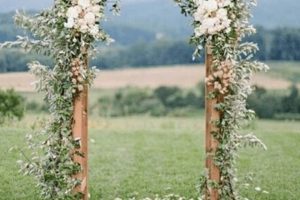
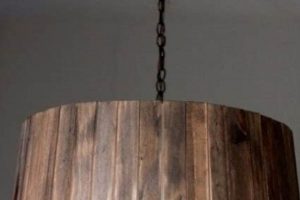
![Creative DIY Mobile Home Skirting Ideas [Guide] The DIY Hub: Creative Crafts, Repairs & Life Hacks Creative DIY Mobile Home Skirting Ideas [Guide] | The DIY Hub: Creative Crafts, Repairs & Life Hacks](https://craftingdiycenter.com/wp-content/uploads/2025/07/th-4605-300x200.jpg)
